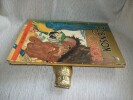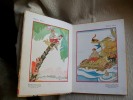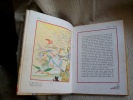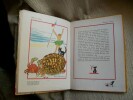[felix lorioux] -
ROBINSON CRUSOE.
Paris Hachette sans date (1930). In-4 72pp. Cartonnage de l'éditeur, dos muet de toile verte, 1er plat entièrement orné d'une belle composition en couleurs. Orné de 34 belles illustrations en couleurs de Félix Lorioux (1 titre-frontispice et 33 à pleine page). Légers défauts en bordure du cartonnage, pliure angulaire au bas des pages 19 et 21, coupure sans manque (5cm) sur la marge inférieure de la page 65. Exemplaire complet, édition joliment illustré en couleurs par Félix Lorioux.
Reference : GITj062
Bookseller's contact details
Librairie Sylvie Nouvène
Mlle Sylvie Nouvène
3304 91 53 24 21
Payment mode
Sale conditions
Les prix annoncés sur le site sont nets, les frais de port sont à la charge de l'acheteur et transmis au moment de la commande. <br />Envois recommandés selon le poids et la valeur et en application des tarifs postaux. <br />Envoi des commandes à réception du règlement. <br />Le paiement se fait par chèque de préférence pour la France Métropolitaine et les DOM TOM, pour l'étranger par virement international, mandat ou autre à définir avec le client. <br />Droit de rétractation applicable dans un délai de 7 jours ouvrés à partir de la réception de la commande. <br /> Les livres commandés sont réservés pendant 8 jours, passé ce délai sans réception du règlement, les livres seront remis en vente.
5 book(s) with the same title
Das Leben und die gantz ungemeine Begebenheiten des weltberuffenen Engellanders Robinson Crusoe, welcher durch Sturm und Schiffbruch (...).Die Zweyte Hamburgische Ausgabe. (+) Das Leben und die gantz ungemein merckwürdigen Begebenheiten Des Weltberühm... - [GERMAN ROBINSON CRUSOE AND RONBINSONADE]
Hamburg, Wierings Erben, 1721 (Part 1) Leipzig, Weidmann, 1721 (part 2) Leyden, Peter Robinson, 1721 (part III & IV). 8vo. Four parts uniformly bound in two contemporary full calf with four raised bands and gilt lettering to spine. Small paper-label to upper part of spines. Wear to extremities. Leather on spine cracked and scratches and soiling to bords. Front board on vol. 3/4 bended with outer margin partly broken off. Annotation in contemporary hand to front free end-paper in both volumes. Title-page and first leaves in vol. 1 soiled and with reapir. Folded plate closely trimmed with loss to lower margin, several tears, with some loss. Internally generally a good copy. [Vol. 1 & 2:] (14), 463, (1), (14), 448 pp. + frontispiece, 1 folded plate, 1 map and 5 plates (wanting 1)." [Vol. 3 & 4:] (6), 624 pp. + frontispiece and 2 plates.
The very rare second edition of the first German translation of Dafoe’s Robinson Crusoe and the equally rare first German translation of Tyssot’s “La Vie, Les avantures, & le Voyage de Groenland”. From a first glimpse the two works seemingly are unrelated whereas in reality they are a fine testament to the Robinson Crusoe-craze that swept through especially Germany in the first half of the 18th century, being one of the earliest, the first or second, example of the literary genre of Robinsonade - a genre that features stories with plots similar to that of Daniel Defoe's ""Robinson Crusoe"". These stories typically revolve around a character who is stranded in a remote or isolated location, often an uninhabited island, and must rely on their own ingenuity and resourcefulness to survive. Both works are rare in themselves. We have not been able to trace a single similar set at auction. ”Tyssot’s second novel (“La Vie, Les avantures…“ here offered) enjoyed a great success in its day. There was only one French edition and whatever attention it attracted probably resulted from the sudden and widespread demand for desert island literature occasioned by the enormous popularity of Defoe’s Robinson Crusoe which was first published in 1719 and immediately translated into French and Dutch and, in the following year, into German. Tyssot’s novel was published in 1720 and was translated into German in 1721. According to Briiggeman, the title of the German edition was originally intended to be Reise um den Nordpol… but this was hastily changed to Des Robinson Crusoe Dritter und Vierter Theil… Perhaps this catch-penny title caused some demand for the novel in Germany although copies are now hard to find.”(Rosenberg, The Voyage De Groenland). “The popularity of Robinson Crusoe in Germany is evidenced not only by the amazing number of editions of the work itself, some of which found in the collection have previously been commented upon but by the large number of imitations which almost immediately made their appearance. If, in attempting to define the term ""Robinsonade,"" one emphasizes particularly solitary isolation from man's companionship with its ""charm that has bewitched the world,"" as Charles Lamb describes the universal romantic appeal of the central theme of Robinson Crusoe then this genre is not large. Include, however, more than one person, and the growing colony of Crusoe easily becomes a Utopia. Transfer the realistic oceans, ships, islands, and cannibals of Defoe to the realm of the unreal, the simple scenery of Robinson Crusoe becoming the romance of the old wonder-filled travel and adventure stories (…).” (Some Imitations of Robinson Crusoe - Called Robinsonades, The Yale University Library Gazette, Vol. 11, No. 2, October 1936) “The first German edition of Defoe’s anti-novel novel appeared in 1720 in Hamburg, published by T. von Wiering’s heirs. The translation was probably done by Ludwig Friedrich Vischer"" “Vischer” signed the translator’s preface and dated it March 26, 1720—only eleven months after the book had first been published by W. Taylor in London. The year 1720 also saw translations of Crusoe into French and Dutch. ""While the exact order in which these editions appeared remains unclear, scholars commonly assume, correctly I believe, that the Amsterdam French edition predated the first German edition in Hamburg, which in turn preceded the Dutch. The Hamburg edition by Wiering’s heirs was immediately pirated in another German edition, perhaps by Jonathan Adam Felßecker, although the title page listed only the information “Frankfurt & Leipzig, 1720.” The second German edition stole even Vischer’s preface, reprinting it in its entirety and signing it simply “des hochgeneigten Lesers Geflissenster der Ubersetzer” (the gentle reader’s most devoted translator). While Vischer purported to rely solely on the English edition for his Hamburg translation, Felßecker’s pirated edition clearly also copied from the French edition published in Amsterdam. While the Hamburg edition featured an engraved frontispiece copied after the original English published by W. Taylor, the frontispiece of the pirated edition copied that in the French translation published by L’Honoré & Chatelain in Amsterdam (fig. 15). Like that edition, the pirated edition was also outfitted with six engravings, which it advertised prominently on its title page. All six were copied after those in the edition that L’Honoré & Chatelain had richly illustrated. Whether French or English, a novelty, after all, needed fashion plates. By September of 1720, yet another edition appeared. This one advertised itself, in the publisher’s informative preface, as the “fifth” German edition. Within six months then, five different German editions of the English anti-novel novel had appeared. This latest edition gave only the year 1720 and “Frankfurt & Leipzig” on its title page (fig. 16). In all likelihood, it had been undertaken by Moritz Georg Weidmann, whose circumspection here contrasts sharply with the engraved portrait done five years later announcing the publisher’s prominence."" (Wiggin: Novel Translations: The European Novel and the German Book, 1680 – 1730).
GRAMOPHONE. ROBINSON CRUSOË. DEFOE (Daniel). DUCRAY (Camille). GOURSAT (G.).
Reference : 13356
Robinson Crusoë (Daniel Defoe).
1 La Voix de son Maître, 1932, 27 x 30.5 cm., reliure de percaline verte estampée, décor central en couleurs de Goursat représentant Robinson et Vendredi, ensemble de six disques "Gramophone" dans des pochettes crème illustrées, reliées et montées sur onglets.
"L'opérette phonographique" inspirée du livre "Robinson Crusoé" est enregistrée par "La Voix de son maître", dont le logo représente un petit chien écoutant un gramophone. Cette oeuvre méconnue d'Henri Christiné fut écrite à l'intention des enfants et était vendue sous la forme d'un coffret renfermant 6 disques. La couverture est illustrée par G. GOURSAT, le livret est signé Camille Ducray et la musique d'Henri Christiné. Les six 78 tours sont interprétés par André Urban (dans le rôle de Robinson Crusoë), Aissa (Vendredi), le chien, le chat, le perroquet (Esau), le Capitaine du navire (Baldouce). chaque pochette comprend une strophe de l'opérette et une phrase musicale avec une portée. Petites usures à la couverture et légères brunissures aux pochettes.
Reference : alb1adbaa12284f35a9
Defoe D. Adventures de Robinson Crusoe. (Robinson Crusoe). In Russian /Defoe D.
Defoe D. Adventures de Robinson Crusoe. (Robinson Crusoe). In Russian (ask us if in doubt)/Defoe D. (Defo). Aventures de Robinson Crusoe. (Robinzon Kruzo). Illustrations by J. Granville. Paris. 1840. 610s. SKUalb1adbaa12284f35a9.
La vie sexuelle de Robinson Crusoé
Au Cercle du Livre Précieux 1963 Un des 1000 ex.de l’édition composée en Garamond Corps 12 numérotée . Version Française. In-8 cartonnage éditeur toile marron. 22,5 cm sur 15,5. 196 pages. Bon état d’occasion.
Michel Le Gall est l’auteur de "La Vie sexuelle de Robinson Crusoé", publié originellement en anglais (The Sexual Life of Robinson Crusoe, 1955) sous le pseudonyme d'Humphrey Richardson. Bon état d’occasion
La vie sexuelle de Robinson Crusoé
Jean CLaude Simoen 1977 In-8 broché 21 cm sur 14. 213 pages. Bon état d’occasion.
Michel Le Gall auteur de "La Vie sexuelle de Robinson Crusoé" a publié originellement en anglais (The Sexual Life of Robinson Crusoe, 1955) sous le pseudonyme d'Humphrey Richardson. Bon état d’occasion
 Write to the booksellers
Write to the booksellers







